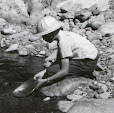As reported
here, ocean beach mining opens Sunday, October 9, for small-scale placer operations. Remember, you need an individual
HPA in hand before you can placer mine on the beaches as the Gold and Fish Pamphlet does NOT fulfill this requirement. (Why miners need an HPA to dig holes in the sand but clam harvesters and sand castle architects do not is beyond me.)
The areas open to mining are in the Seashore Conservation Area which is defined in
RCW 79A.05.605 as
...all lands now or hereafter under state ownership or control lying between Cape Disappointment and Leadbetter Point; between Toke Point and the South jetty on Point Chehalis; and between Damon Point and the Makah Indian Reservation and occupying the area between the line of ordinary high tide and the line of extreme low tide, as these lines now are or may hereafter be located, and, where applicable, between the Seashore Conservation Line, as established by survey of the Washington state parks and recreation commission and the line of extreme low tide, as these lines now are or may hereafter be located; and shall also include all state-owned nontrust accreted lands along the ocean: PROVIDED, That no such conservation area shall include any lands within the established boundaries of any Indian reservation.
Precisely where these "
lands now or hereafter under state ownership or control" which are open to mining lie
is unknown to this writer and may take some research in the property records of Clallam, Grey's Harbor, Jefferson, and Pacific counties to determine. I have heard that the Washington Department of Fish and Wildlife (WDFW) has a map or maps showing which areas are open to mining but this writer has yet to locate a copy. In any event, here is a map taken from
Handbook For Gold Prospectors In Washington by Wayne S. Moen and Marshall T. Huntting, Information Circular 57, Washington Department of Natural Resources, Division of Geology and Earth Resources, 1975, page 36, showing where gold was found in beach deposits in the past. (NOTE: The locations shown below are for historical information only and are NOT necessarily open for prospecting under the new rules. Check the appropriate land ownership or WDFW map records - if they exist - before mining.)
 |
| Historical Beach Placer Locations (Click to enlarge.) |
The following placers numbered on the map above are described in Information Circular 57:
1 - Shi Shi Beach: Beach between Portage Head and Point of Arches in Sections 18, 19, and 30 Township 32N Range 15W. Beach deposit in which a thin layer of fine heavy sand rests on a wave-cut terrace in sandstone overlain by 1 to 3 feet of gravel and sand. Gold and platinum are found in the thin layer and in cracks in the bedrock.
2 - Ozette Beach: Section 12 Township 31N Range 16W. Beach deposit of gold and platinum concentrated along surface of a wave-cut terrace in sandstone.
3 - Little Wink: Center S½SW¼ Section 1 Township 30N Range 16W. Reworked Pleistocene gravels in a beach placer.
4 - Morgan: NW¼NW¼NE¼ Section 12 Township 30N Range 16W. Reworked Pleistocene gravels at high-tide level.
5 - Morrow: SW¼SW¼ Section 18 Township 30N Range 15W. Beach deposit in which there is a 2-foot layer of gravel reworked by wave action from Pleistocene gravel. Spotty fine gold content averaged $4.00 per cubic yard at $20 gold.
6 - Yellow Banks: 2 miles south of Sand Point in SW¼ Section 18 Township 30N Range 15W. Beach deposit of gold and platinum concentrated on surface of a wave-cut terrace in Pleistocene drift.
7 - Main and Bartnes: NW¼NW¼ Section 19 Township 30N Range 15W. Sand and gravel cemented by clay and iron oxide.
8 - Johnson Point: NW¼ Section 5 Township 28N Range 15W. Beach placers and gold in Pleistocene deposits of the bench adjacent. Some pans of sand ran as high as 60 cents Au and some panners recovered $2 to $10 per day at $20 gold.
9 - Cedar Creek: Near mouth of Cedar Creek in E½ Section 18 Township 29N Range 15W. Gold and platinum occur in a beach placer in a 2- to 15-inch sand layer on the surface of a wave-cut beach in clay. The sand layer is said to be 400 feet long and 100 feet wide at low tide. Said to yield from 2 to 5 pennyweights of gold and platinum per cubic yard. Ratio of Pt to Au ranges from 1:5 to 1:15.
10 - Sunset Creek: Section 19 Township 29N Range 15W.
11 - Ruby Beach: E½NE¼ Section 31 Township 26N Range 13W. On tombolo (a sand bar connecting an island to the mainland or to another island) between Abbey Island and Ruby Beach. Very fine grained gold in beach sand.
12 - Moclips River: Section 8 Township 20N Range 12W.
13 - Oyhut: On ocean beach at Oyhut. Beach placer. Assays 72 cents gold per ton at $20 gold.
14 - Point Brown: Sections 15 and 23 Township17N Range 12W.
15 - Ocean Park: Ocean beach at Ocean Park. 87 cents gold per ton at $20 gold.
16 - Fort Canby: Mouth of Columbia River near Fort Canby. Sand. 81 cents gold per ton at $20 gold.
17 - Sand Island: Island at mouth of Columbia River just south of Ilwaco. Sand. $1.51 gold per ton at $20 gold.
See Information Circular 57 at the link above for more details.









